Understanding Qualcomm's Snapdragon 810: Performance Preview
by Joshua Ho & Andrei Frumusanu on February 12, 2015 9:00 AM EST- Posted in
- SoCs
- Qualcomm
- Mobile
- Gobi
- Snapdragon 810
GPU Performance
Last but certainly not least, we have GPU performance. As we mentioned earlier, the Snapdragon 810 introduces Qualcomm's Adreno 430, the latest member of the Adreno 400 GPU family. Qualcomm's own performance estimates call for a 30% increase over Adreno 420, with a final GPU clock of 600MHz being identical to the Snapdragon 805's (Adreno 420) own GPU clock speed.
From an architectural standpoint Adreno continues to be something of a black box for us. Other than being a modern OpenGL ES 3.1/AEP design, we don't know too much about how the GPU is laid out, and Qualcomm's current legal battle with NVIDIA likely not helping matters. In any case, Qualcomm has indicated that Adreno 430 is not just a simple extension of Adreno 420, so we may be looking at an architectural change such as wider shader blocks.
For today's benchmarks, as we mentioned before we only had a limited amount of time with the Snapdragon 810 and had issues with BaseMark X. We've had to pare down our GPU benchmarks to just 3DMark 1.2 and GFXBench 3.0. Once we get final hardware in, we will be able to run a wider array of graphics benchmarks on Snapdragon 810.
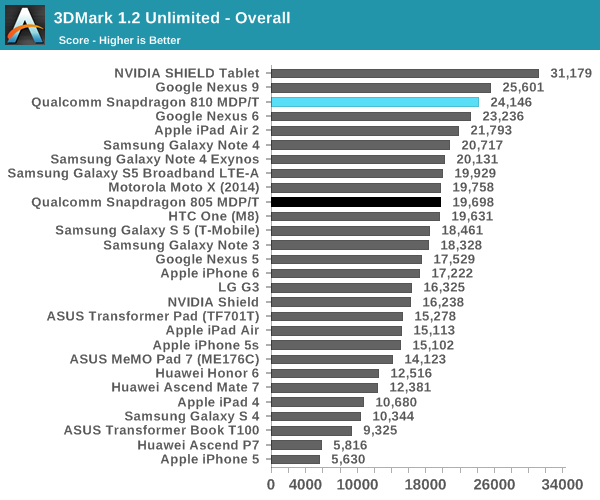
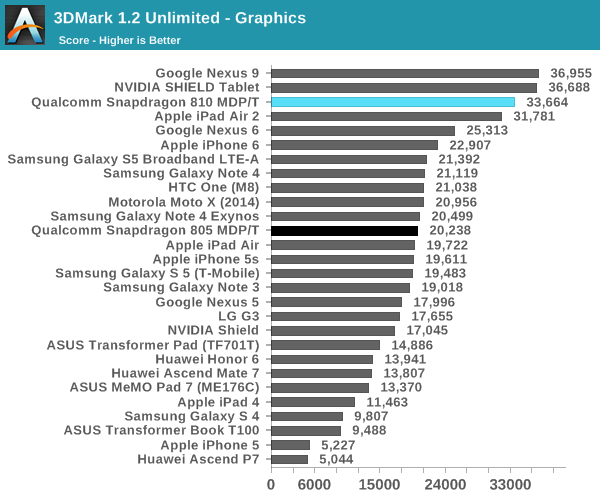
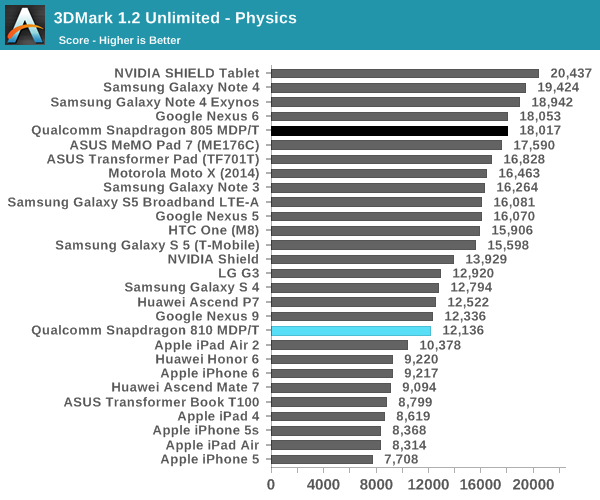
Starting off with 3DMark, compared to the Snapdragon 805 reference platform the actual graphics performance advantage is even greater than 30%, coming in at closer to 65%. However since drivers play a big role in this, a more recent 805 platform like the Nexus 6 may be a better comparison point, in which case the gains are 33%, just a hair over Qualcomm's own baseline performance estimate. We also find that Snapdragon 810 oddly struggles at physics performance here, underperforming Snapdragon 805 devices, something the Exynos 5433 didn't have trouble with. As a result overall performance is only slightly improved over the Nexus 6.
Continuing with GFXBench, we look at more pure GPU loads. One has to take note that the MDP/T employs a 4K screen resolution, and the on-screen results will likely suffer from that.

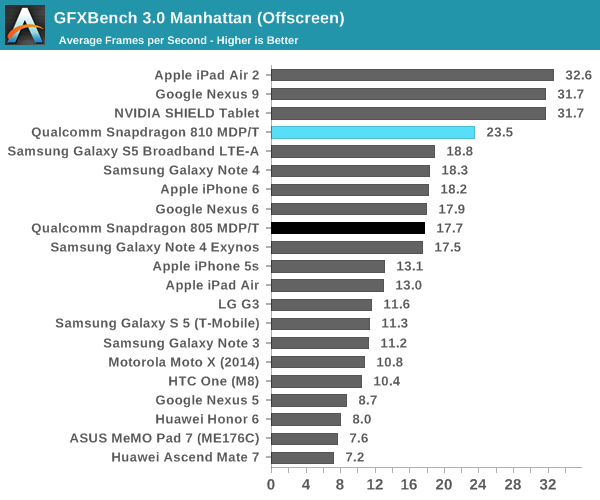
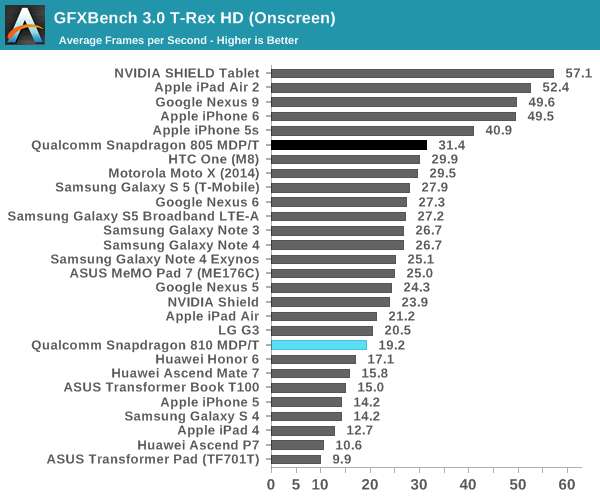
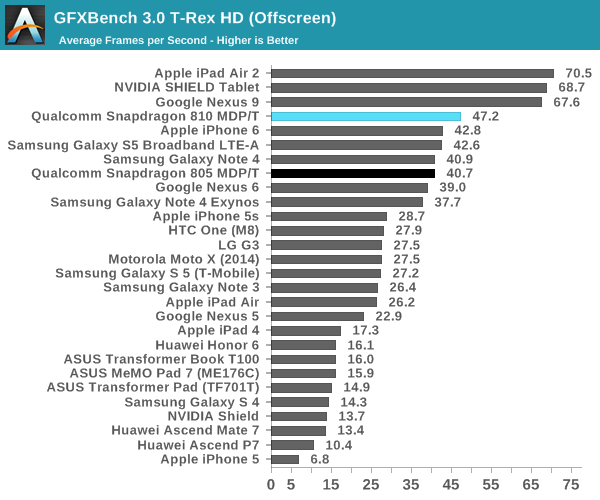
Under GFXBench 3.0's full rendering tests of Manhattan and T-Rex, the Snapdragon 810 continues to show considerable performance gains over the Snapdragon 805. Ignoring the onscreen results for now since the Snapdragon 810 reference platform runs at such a high resolution, offscreen results show the 810 outperforming the 805 by 33% in Manhattan and 16% in T-Rex. The former is again well in-line with Qualcomm's performance estimate, wile the older T-Rex benchmark doesn't show the same gains, possibly indicating that Adreno 430's biggest gains are going to come from shader-bound scenarios.
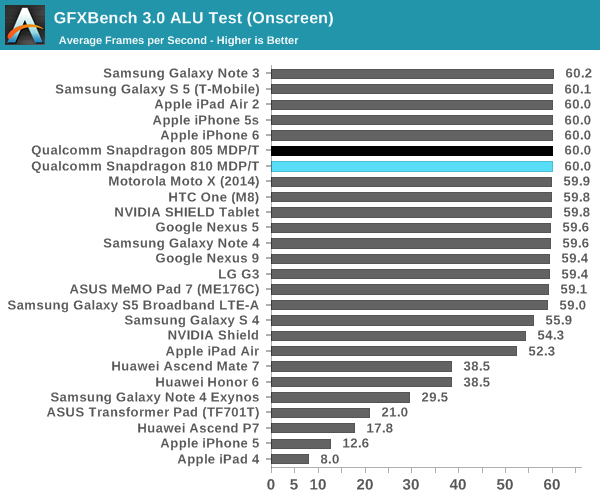
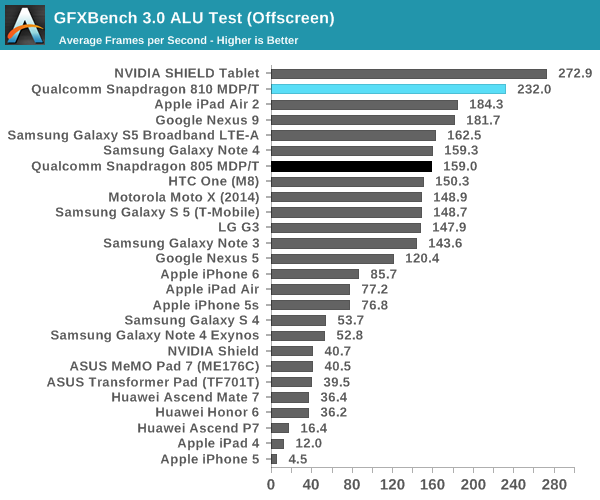

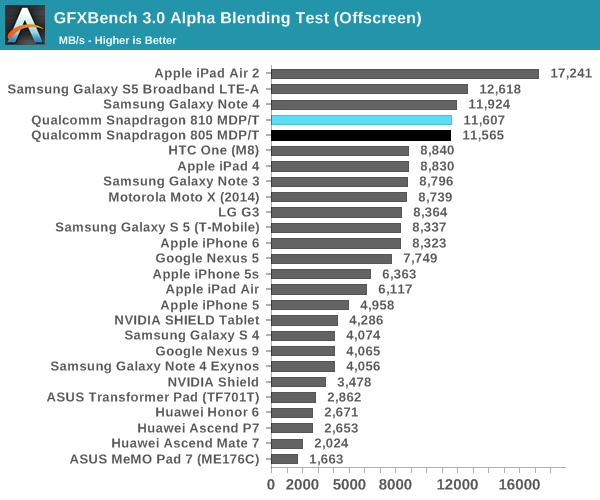
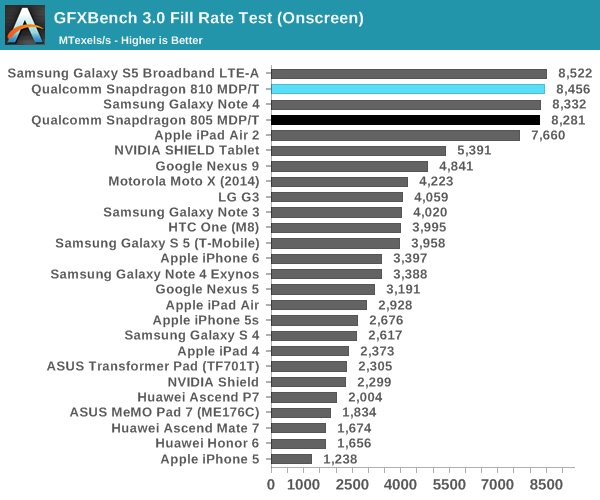
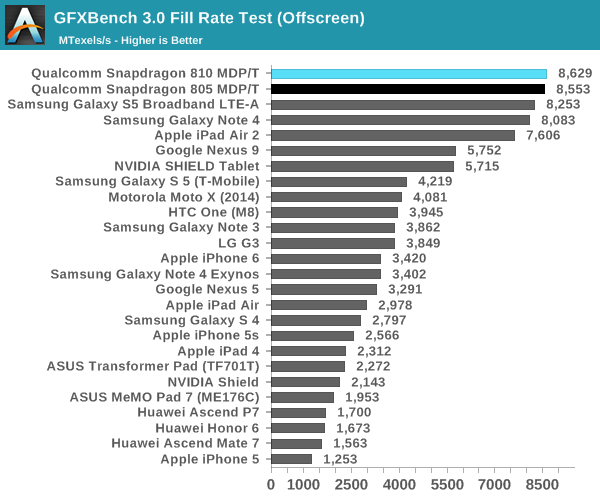
Meanwhile GFXBench's synthetic tests continue to put Adreno 430 and the Snapdragon 810 in a good light. ALU performance in particular is showing very large gains - 46% better than the Snapdragon 805 and Adreno 420 - while our blending and fillrate tests show almost no gain over Snapdragon 805. This adds further credence to our theory that Qualcomm has widened or otherwise improved Adreno's shader blocks for 430, as other elements of the GPU are not showing significant performance changes.
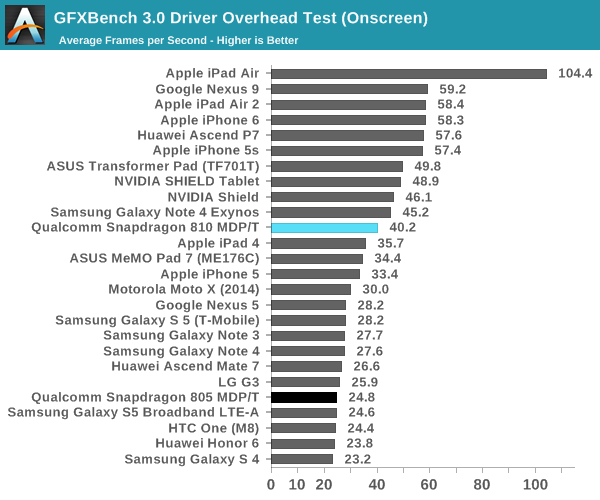
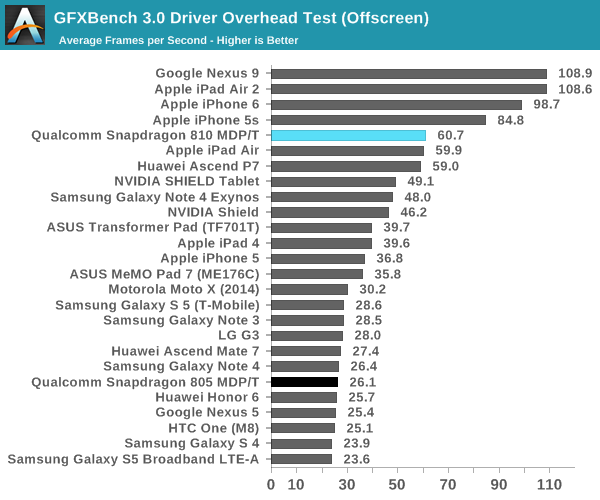
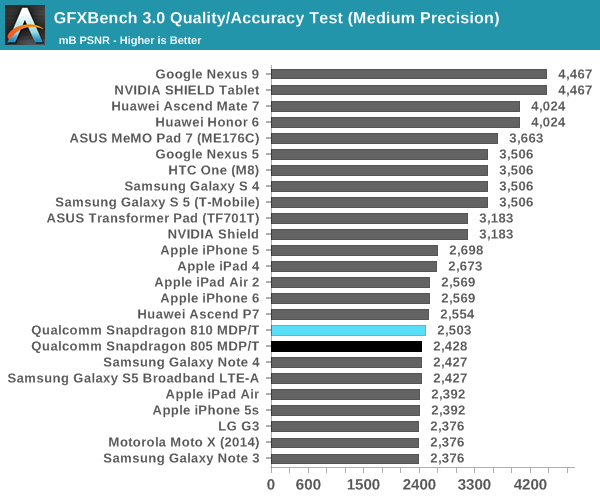

Finally, GFXBench's driver overhead and accuracy tests are more or less what we would expect for Snapdragon 810. In the case of driver overhead, a combination of newer drivers and a much faster CPU have reduced the CPU cost of driver overhead. Meanwhile with the underlying GPU architecture being unchanged, there are no material changes to quality/accuracy.
Overall then the performance gains for the Adreno 430 and Snapdragon 810 seem to be almost exclusively focused on shader performance, but in those cases where rendering workloads are shader bound, Qualcomm's 30% estimate is on the mark. Real-word performance gains meanwhile are going to depend on the nature of the workload; games and applications that are similarly shader-bound should see good performance gains, while anything that's bottlenecked by pixel throughput, texturing, or front-end performance will see much smaller gains. Thankfully for Qualcomm most high-end workloads are indeed shader bound, and this is especially the case when pushing high resolutions, as Qualcomm is trying to do with their 4K initiative for Snapdragon 810. However in the case of 4K, while Adreno 430 offers improved performance it's still slow enough that it's going to struggle to render any kind of decently complex content at that resolution.
As for Adreno 430 versus the competition, Qualcomm has narrowed much of the gap between themselves and NVIDIA/Apple, but they haven't closed it. Apple's Imagination GX6850 and NVIDIA's K1 GPUs continue to hold a performance advantage, particularly in GFXBench's Manhattan and T-Rex full rendering tests. Both Apple and NVIDIA invested significant die space in graphics, and while we don't know how much Qualcomm has invested in Adreno 430 with Snapdragon 810, it's safe to say right now that they would need to invest even more if they want to beat the graphics performance of NVIDIA and Apple's tablet SoCs.










119 Comments
View All Comments
phoenix_rizzen - Thursday, February 12, 2015 - link
Asus ZenPhone 2 uses an Intel chipset.There's a couple of other ones as well.
blanarahul - Thursday, February 12, 2015 - link
It's probably at Snapdragon 800 level. Intel won't compete with S810 and best Exynos' of the world until Airmont.... Well, atleast I hope so. *sigh*serendip - Friday, February 13, 2015 - link
Intel on Android also has problems with app compatibility and speed, despite Intel's assurances to the contrary. Apps with ARM-compiled native codeserendip - Friday, February 13, 2015 - link
Apps with ARM-compiled native code either don't run or run slowly under the code translator. It's almost like Intel is giving away these phone and tablet Atom SOCs to get a foot in the mobile market. I'm quite happy with my cheap Windows 8.1 tablet but Android on Intel has a way a to go yet.(the lack of comment editing isn't fun, especially when the Submit Comment button is so easy to click)
phoenix_rizzen - Friday, February 13, 2015 - link
That's for (mainly) games developed using the Android NDK, correct? Doesn't the switch to the Android RunTime (ART) and pre-compiling the apps at install time mitigate this? Or does ART not apply to NDK apps?jjj - Thursday, February 12, 2015 - link
Look at the phrasing from 2 articles at just a few days distancein this one - Thanks in large part to the new cryptographical capabilities of the ARMv8 cores, Snapdragon 810 gets off to a very good start in Geekbench 3's integer benchmarks ....Snapdragon 810's overall performance improvement here is a rather large 45%, though if we throw out the especially large gains that come from Lua MT, the overall performance advantage is closer to 30%.
and from the Note 4 - GeekBench's integer benchmarks paint a similar picture - if we disregard the huge boost to the cryptography scores we see an average advantage of 31% for the Exynos 5433's A57 cores, or 29% when we normalize for clock speeds.
So for the Note they clearly point out and discard the encryption gains and they normalize for clocks. That's good and fair and the proper way to look at it. (although quantifying the importnace of the encryption gains would be a plus).
Here not only encryption is left alone but clocks are not even mention, some readers might not be even aware that there is a clock difference.
The tone and objectivity are fundamentally different, a nice review for the Note while here it's all about easing concerns and making SD810 look good.
Sushisamurai - Thursday, February 12, 2015 - link
+1. It's not unethical, because it's on a reference platform that Qualcomm is sourcing out. It'd be "unethical" (your terms, not mine - I would use the word disappointing) if they didn't give investigate throttling and power for actual, retail/shipping devices. But I haven't been disappointed yet so....gonchuki - Friday, February 13, 2015 - link
2015 was already going to be a good skip year with flagships already going full retard at 6'' in late 2014 and already gimping the specs of 5'' phones just to increase the sales of their higher margin phablets.Andrei Frumusanu - Thursday, February 12, 2015 - link
I added the clocks for the CPU, apologies the article was still being edited when published.As for power and thermals, we have no way to test these until we get a shipping review device with the SoC. Josh had only a couple of hours on hand with the MDP, making more extensive testing not possible. Calling that unethical is pretty harsh.
warreo - Thursday, February 12, 2015 - link
Andrei, power and thermals aside, I notice you didn't address why there was not a greater focus on Exynos vs. S810? At bare minimum, you should include the % difference in the table in addition to the difference vs. S805. The absence of any kind of discussion there makes it easy for people to cry unethical, NOT the absence of power and thermals, which as you said, was due to lack of testing time.